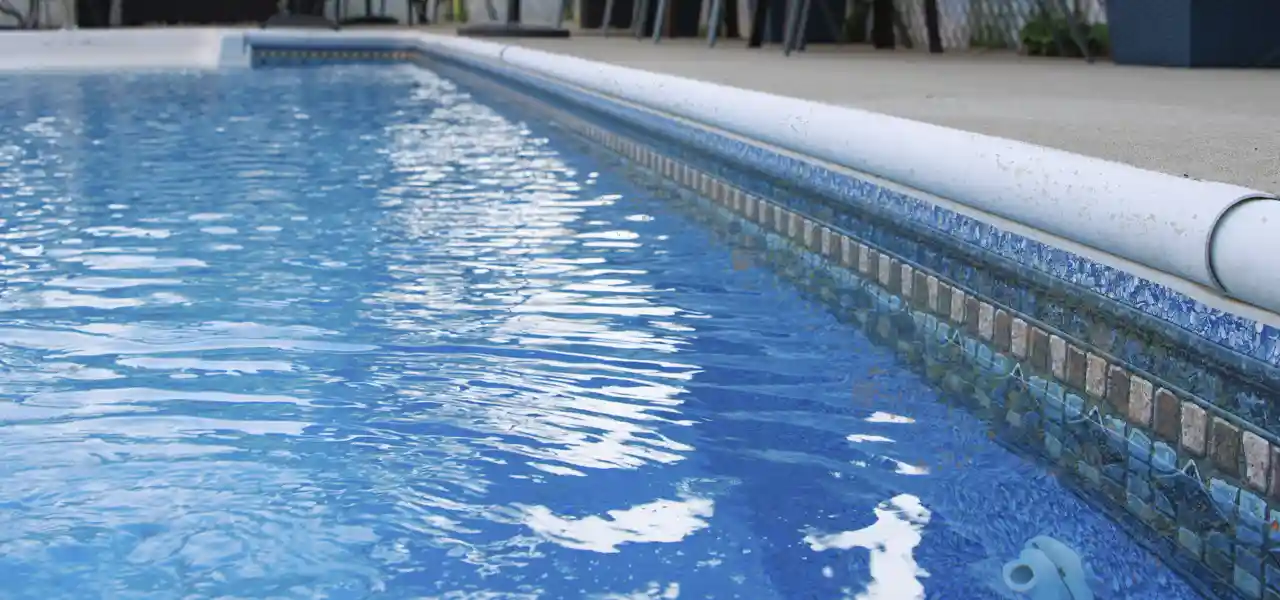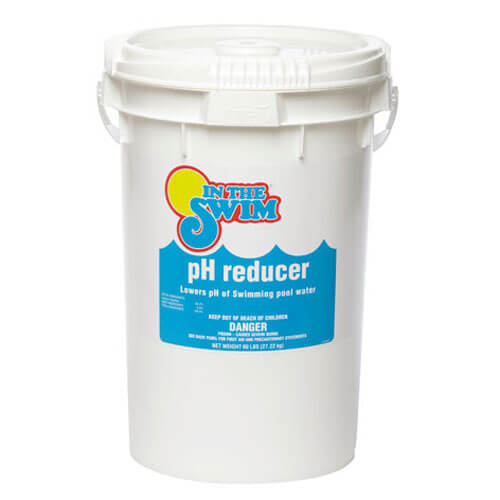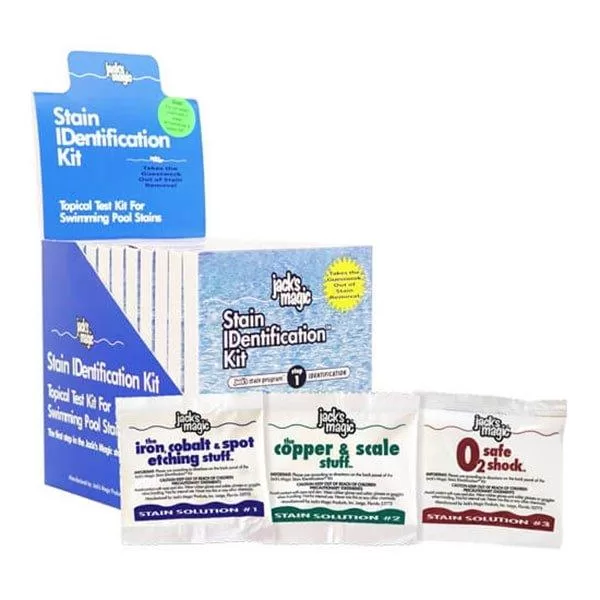FREE Standard Shipping On All Orders $100 or More!*

Stains and Discoloration in a Vinyl Liner Pool
Above ground and inground pools both use vinyl liners and are susceptible to staining from minerals, organic materials and chemical damage. Vinyl pool liner stains are not only unsightly, but cause damage to your pool overtime.
Identifying and cleaning stains out of your vinyl-lined pool quickly is key to avoiding liner damage. This post will help you identify what is causing your vinyl liner pool stains, and how to remove the stains for good.
How to Identify Vinyl Pool Liner Stains
One advantage of vinyl pool liners is that the slick surface often reduces mineral staining. It's not uncommon to see the pool stains more pronounced on plastic and metal items in the pool, such as on your ladders, steps, and pool lights.
Vinyl liners can also stain in localized areas or spread throughout the pool surfaces. It can be just one small spot, only at the waterline, or on the pool steps. Size, color, location, and any behavior of the pool stain can identify the source or cause of the stains.
Testing your pool water for metals and mineral content can also identify pool stains. So test your water for iron, manganese, or copper.
Mineral Pool Stains

Mineral pool stains can be every color of the rainbow, but a few are more common. Blue-green stains develop from too much copper in the water. Iron pool staining can be brown, red, or yellow-orange in color. Calcium or sodium salts can leave a sort of white deposit on your pool liner.
For stains on a horizontal surface, you can test the surface for mineral staining by using a small amount of acid on the stain. Place a vitamin C tablet (ascorbic acid) on the stain for a short time. You can also use a pH decreaser (sodium bisulfate) placed into a sock. If the stain lightens considerably, you have a mineral stain on your hands.
Metal Pool Stains
Iron, copper, and manganese can come out of the solution if your pool water has high levels of metals. Heavy doses of copper algaecide can lead to blue-green staining of pool liners. Maintaining proper pH in your pool is important to mineral stain prevention.
High or low pH can lead to metals coming out of solution to stain your pool. A common problem is copper heat exchangers in gas pool heaters corroding from low pH or from chlorinators backing up when the pump is shut off.
Organic Pool Stains
Organic stains come from dead algae or other small animals, or from the tannins contained in leaves and plant debris, such as leaves, twigs, acorns, and berries. It could also come from worms, bacteria, and algae, as well as pollen and pollution.
Organic stains can present in a range of colors, from yellow to brown to black. These stains normally occur after a long winter, after a big thunderstorm, or from a sudden change in water chemistry.
Your open pool absorbs all sorts of organic matter every day. Cleaning, sanitation, and filtration keep it under control usually. Organic liner stains are often easily removable.
Organic chemicals respond to chlorine, applied directly on the surface. Sometimes just shocking the pool will lighten or remove organic pool staining. Place a chlorine tablet on a stained area for just one minute. If the stain lightens, then you have an organic pool stain.
Chemical Damage

Fading to the vinyl liner occurs over time from the sun, or from elevated chlorine or low pH levels. Broadcasting granular chemicals into a vinyl liner pool is generally a no-no; instead, pre-dissolve them into a bucket of water first. Chemical or UV damage is not considered a stain on the pool surface and is generally not treatable.
Unsure which type of vinyl pool stain you have? The Jack's Magic Stain ID kit helps you determine what the next best steps would be to remove your particular type of pool stain.
For many vinyl liner stains, the prescription from Dr. Jack will be Vinyl Liner Blue Stuff, a powerful sequestrant that prevents and removes stains on vinyl pools. For metal stains, either Stain Solution #1, the Iron, Cobalt & Spot Etching Stuff, or #2, the Copper & Scale Stuff may be indicated, depending on the metals discovered.
How to Remove Vinyl Pool Liner Stains
Stains on the vinyl can come from any of the sources above. You may know exactly what the stain is based on evidence gathered at the site. Is it metals or organics? Does it brush off or rub off?
The first thing to do is clean the pool. A clean pool and a clean filter are proper preparation for stain removal and a good place to start. Skim, vacuum, and brush.
The second thing to do is balance your pool water chemistry. In some cases, merely adjusting the pH, alkalinity and calcium hardness levels can lighten or remove some types of pool stains. Use a fresh pool test kit or test strips, and adjust your pH to 7.5, alkalinity to 100 and calcium hardness to 200.
The third step after balancing the water is to shock the pool, using either non-chlorine shock or chlorine shock (pre-dissolved in a bucket before adding).
If this didn't remove the stain, no worries, it is part of the stain removal process. Vinyl liners can't be drained or acid washed, and draining or pressure washing typically don't help. Vinyl pool stains need to be removed more gently.
Mineral Pool Stains
Generally speaking, mineral pool stains respond best to a treatment with acids. Plaster pools may be acid washed or a stain-master used for localized rust stains, but you can't acid wash a vinyl liner pool, can you?
Vinyl pool stains can be removed with acidic stain removal products like Stain Free, or A+ Stain Remover, or Jack's Magic Blue Stuff for vinyl liners. If the stain is on your vinyl pool steps, try Jack's Magic Step Stuff. Ascorbic acid (yep! vitamin C) is a great product for removing mineral stains on vinyl pools, and it also works well on vinyl pool step stains.
To keep metal and mineral stains from returning, add a sequestering agent twice per year, to keep minerals sequestered, or locked in solution. Or you can use a CuLator PowerPak, the only product that actually removes minerals from your pool by absorbing them in an easy-to-use pouch that you drop into your skimmer basket.
Organic Pool Stains
Generally speaking, organic pool stains respond best to a treatment with oxidizers. For plastered pools, you can just dump powdered shock right onto the bio-stain and watch it instantly disappear, but you can't do that with a vinyl liner pool.
Organic pool stains can deposit themselves only around the main drain, on the steps or corners of the pool. Balance the chemistry and add super pool shock, according to directions. If that doesn't remove the organic stains, try one of the products listed above. They are safe for vinyl liners, and they work for both mineral and organic pool stains.
Stains Behind Liner
Some stains are actually behind the liner, in between the wall or floor and the liner. They start as a bacterial colony, or can be algae or mineral crystals. If they are dark enough and large enough, they may show through the somewhat opaque pool liner and appear as a stain. Short of pulling up the liner and treating the floor, and foaming the walls, what can you do when the stain is behind or underneath the liner?
Start with the methods above: good water balance and give a heavy chlorine shock. This may only work temporarily. If the stains are near the waterline or high on the wall, you can lower the pool water and get at the wall with a scraper, then place a barrier between the wall and the liner.
Stains on Steps and Ladders
For steps and ladder stains, which can sometimes turn an off-orange, or light brown color, usually from leaf tannins, Jack's Magic makes an easy-to-use product called the Step Stuff.
Stain Free or Stain Free Extra Strength can also work miracles with vinyl pool steps that have gradually or suddenly changed their colors, often turning a dirty brown, gray, or orange color.
Stains on the Waterline
Stains at the water line can develop over time on a vinyl pool. They are a mixture of dirt, minerals, oils, pollen, etc., that sticks to the edge of the pool, and are usually easily removable. Use a pool tile and vinyl cleanser. Don't use any sort of kitchen or automotive cleaners on the pool.
Lower the water and use a kitchen sponge with a textured side. Spray on a small amount of tile/vinyl cleaner, or use the all-natural Orb3 Enzyme Cleaner and clean in rotating motions. Stains at the waterline have a greasy film and require a little elbow grease to remove, but don't scrub too hard, or you may actually begin to rub off the printed pattern.
Adding a pool enzyme product can keep waterline stains from returning. Use Natural Chemistry's Pool Magic or Pool Perfect and stop scrubbing the pool or steps every month.
How to Prevent Vinyl Pool Liner Stains
Preventing pool liner stains requires vigilance! Watching the pool like a hawk for foreign objects, keeping it clean, and keeping it balanced are the main ways to keep stains off your pool liner, with special attention to how you add pool chemicals.
Keep it clean. Almost anything on your liner or steps long enough will make a stain. Leaves and twigs leach colors, but are easy to remove with high chlorine and a little brushing. Worms or dead animals are a more difficult stain to remove and may require a stain remover chemical.
Add chemicals. Many vinyl staining problems occur immediately after large-scale water balance adjustments or shocking of the pool. To avoid this, add chemicals separately at least four hours apart, and always add large doses in small increments over 24 hours.
To control pool stains from metals and minerals, use Jack's Magic Purple Stuff or MetalFree. For severe mineral and metal issues, a CuLator PowerPak will reduce levels.
These stain-prevention pool chemicals control pool staining by making it difficult for minerals in the water to precipitate out of solution, where it can stain your vinyl liner, steps, or ladders.